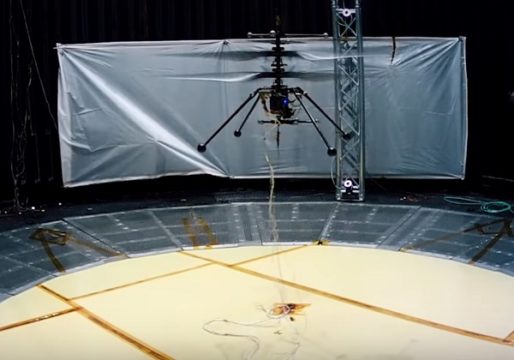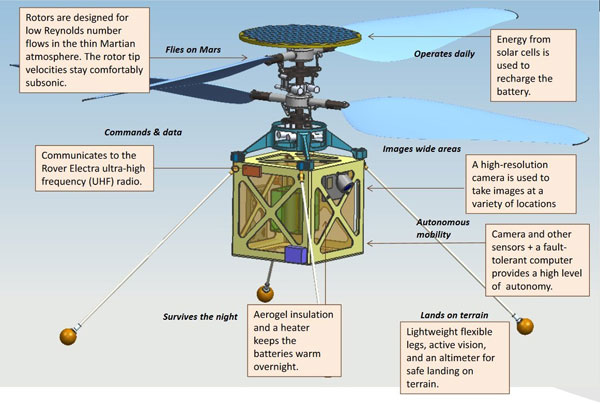A small helicopter will be the first mission to fly through the skies of Mars.

NASA/JPL-Caltech
A small helicopter will soon be making its way to Martian skies.
NASA recently announced that a small autonomous helicopter will make the journey with the Mars 2020 Rover. The Mars Helicopter Scout will be the first mission to fly on another planet. The drone-style helicopter will pave the way for future aerial scouts on Mars and other worlds.
Weighing in at 2.2 lbs (1 kg), the baseball-size helicopter will use a pair of 3-foot, 7-inch (1.1-meter) rotor blades. Powered by solar cells and a rechargeable lithium ion battery, these blades will beat at 3,000 rpm to create lift in the tenuous Martian atmosphere.
The altitude record for a helicopter here on Earth is about 40,000 feet. On Mars, the surface density of the thin atmosphere is equivalent to 100,000 feet above sea level on Earth. “To make it fly at that low atmospheric density, we had to scrutinize everything, make it as light as possible while being strong and as powerful as it can possibly be,” says Mimi Aung (NASA-JPL) in a recent press release. A prototype demonstrated its flying capability in a simulated Mars environment here on Earth.

NASA / JPL-Caltech
Tucked away in the belly pan on the underside of the Mars 2020 rover, the Mars Helicopter Scout will be deposited on the Martian surface shortly after the sky crane landing. The helicopter will be autonomous, owing to the 3- to 22-minute communications lag between Mars and Earth. It will also incorporate a heating element to keep it warm on cold Martian nights.
Soaring Through Alien Skies
The Mars Helicopter mission was funded for $23 million early this year, and is expected to last about 30 days. NASA plans to complete at least five short flights with the Mars Helicopter.The first flight will make an initial vertical climb of 10 feet (3 meters). Journeys up to 90 seconds in duration will range over several hundred meters on subsequent sorties.
"There are no science instruments aboard the Mars Helicopter — it is a technology demonstrator," says DC Agle (NASA HQ). "For the purpose of demonstrating taking images of the terrain from a helicopter in-flight, it will carry a a grams-class color camera."
Nevertheless, the Mars Helicopter could prove to be a valuable asset, mapping the terrain ahead for possible hazards and scouting out sites of opportunity to explore for the Mars 2020 Rover. And hey, we might just see some intriguing selfies of the Rover on the surface of Mars, another first
“The ability to see clearly what lies beyond the next hill is crucial for future explorers,” says Thomas Zurbuchen (NASA-Science Mission Directorate) in a recent press release. “We already have great views of Mars from the surface as well as from orbit. With the added dimension of a bird's-eye view from a 'marscopter,' we can only imagine what future missions will achieve.”

NASA / JPL-Caltech
The nuclear plutonium-powered Mars 2020 Rover, a souped-up successor to the Mars Science Laboratory Curiosity, will launch atop an Atlas 5 rocket in July 2020. While the current 2018 launch window saw only one launch, carrying the Mars InSight mission and the Mars Cube One CubeSats, the launch window in 2020 will be packed. The European Space Agency's ExoMars Rover, United Arab Emirates' Mars Mission, China's first Mars mission, and the Japanese Aerospace Exploration Agency's Mars Terahertz MicroSatellite are also scheduled to make the trip.
Smaller secondary "scout ships" could become a standard feature for future missions. One place NASA would like to fly a nuclear-powered helicopter is the dense atmosphere of Titan, a project that's in the running for the next New Frontiers mission for the coming decade, up against the CAESAR sample return to Comet 67/P Churyumov-Gerasimenko.
The Mars Helicopter mission is what NASA considers a high-risk, high-reward project. Like the Mars Cube One hitchhikers that launched with the InSight lander, the success of the primary mission isn't impacted by the performance of the Mars Helicopter demonstrator. But if it's successful, the Mars Helicopter could pave the way for an exciting new generation of planetary explorers.
 3
3









Comments
Tommy-Howe
May 18, 2018 at 9:16 pm
This is the most exciting news that I've heard in a long time and wonder why such an obviously useful companion to the Rover hasn't been discussed before.
Just a fabulous idea!
You must be logged in to post a comment.
Frank-Brewer
May 21, 2018 at 7:38 am
Conceivably the helicopter could 'dust off' solar panels. Will Rover 2020 be in range to assist any current rovers or other on-site equipment?
You must be logged in to post a comment.
David DickinsonPost Author
May 21, 2018 at 4:27 pm
Depends on the landing site selection. One that is in the running is the home of the Spirit rover, though these test flights will be pretty short, and the landing ellipse will probably be larger.
You must be logged in to post a comment.
You must be logged in to post a comment.